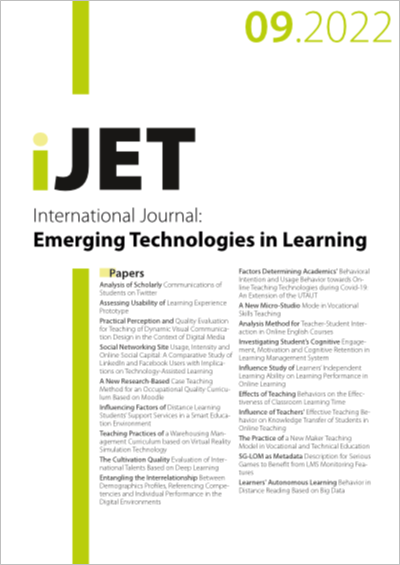Learners' Autonomous Learning Behavior in Distance Reading Based on Big Data
DOI:
https://doi.org/10.3991/ijet.v17i09.31373Keywords:
big data, distance reading instruction, autonomous learning, behavior analysis, rough setAbstract
Some learners couldn’t get ideal learning results from distance education, to find out the root of this problem, their learning behavior and initiative should be analyzed in real time. However, in existing research results, the collected distance learning behavior data of learners are not pertinent enough, the extraction methods of big data are not proper enough, and the analysis models of learning behavior are not scientific enough. For these reasons, this paper analyzed the autonomous learning behavior of learners during distance reading based on big data, and gave the analysis contents and methods. In the text, a sequence diagram transformation method that is self-adaptive to long and short sequences had been introduced to process the learning behavior data of learners, who were then classified according to the features of different autonomous learning behavior sequences. Then, an attribute reduction algorithm based on improved Bayesian fuzzy rough set was adopted for attribute reduction, and the behavior indexes that are closely related to the autonomous learning effect of learners were selected for correlation analysis. After that, this paper proposed a method for detecting non-autonomous learning behavior based on multiple time scales, combining short-term autonomous learning pattern with long-term autonomous learning behavior and resource access behavior, this paper also analyzed the typical autonomous learning pattern of learners through the learning of hidden layer features. At last, experimental results proved the effectiveness of the proposed analysis method.
Downloads
Published
How to Cite
Issue
Section
License
Copyright (c) 2022 Nan Zhang (Submitter); Shuliang Huan, Cuibi Yang

This work is licensed under a Creative Commons Attribution 4.0 International License.


